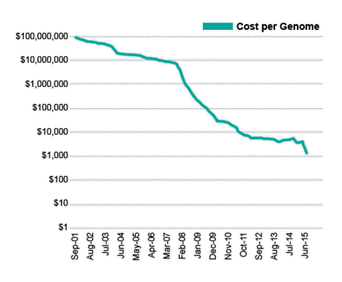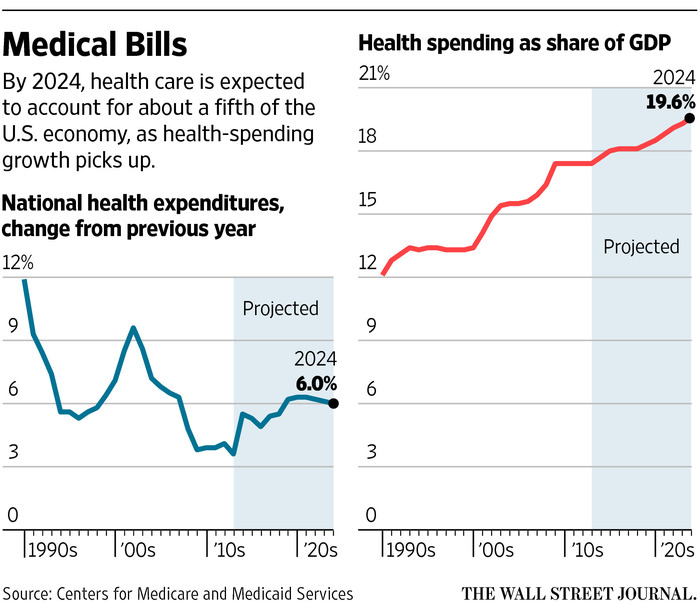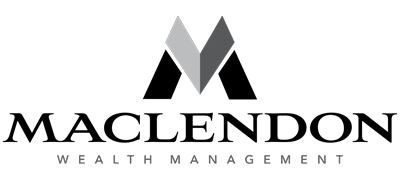
08 Aug Dose of Healthcare
We are constantly looking at innovative companies and one that caught our attention is named after the 23 pairs of chromosomes that humans have in each cell called 23andMe. For those of you that don’t know, 23andMe is a personal genetics company that for $200 will test your saliva and send you a genetic profile report. The report includes information such as your ancestry, specific traits, and whether or not you are a carrier of certain hereditary conditions. To think that for $200 you can have all of that information is a testament to the advances through research and development in the healthcare sector. Putting the advancement into perspective, take a look at the chart below. In 2001, it cost nearly $100 million dollars to sequence a genome and today that same process only costs around $1,000.
Source: National Human Genome Research Institute, as of 7/31/2015
This is just one example of the many advancements that has us excited for innovation in healthcare and medicine over the next decade. From an investment perspective, the health care sector consists of companies engaged in manufacturing medical equipment, supplies and pharmaceuticals, as well as operating healthcare facilities and provision of managed healthcare. As a sector, healthcare is considered to be defensive in nature, due to the fact that its products and services are largely essential. Most people don’t cut their health spending, even during a recession. After all, if you have a serious medical condition, you’re going to the hospital—no matter the state of your finances. Because of this consistent demand for goods and services, health care companies are less sensitive to business cycle fluctuations.
From a macroeconomic perspective, the backdrop is favorable for the sector. With the Affordable Care Act providing more than 11 million Americans with health insurance, healthcare accounts for 15% of the S&P 500 and represents about 20% of U.S. total government spending as a percent of GDP. In addition, the global population is aging, which will require all types of healthcare products and services while also increasing health care utilization over time. The expanding middle class in emerging markets is having a growing impact on the market. Incomes are rising in many emerging markets, further increasing spending as this relatively new population has more money to spend on health care. As unemployment levels fall, more people have access to insurance and are more likely to utilize their health insurance benefits that may have otherwise been postponed.
Supportive legislation by the Food and Drug Administration (FDA) has also bolstered our view on healthcare. The FDA is responsible for protecting public health by assuring the safety and efficacy of drugs and advancing public health by speeding up access to new products. Through the FDA’s Safety and Innovation Act, a new and powerful expedited drug development tool, known as the “breakthrough therapy” designation helps assist drug developers to expedite the development and review of new drugs. “Breakthrough therapy” is one of four FDA approaches to make new drugs available as rapidly as possible. The others are priority review, fast track and accelerated approval. This has led to an innovation wave across all parts of the sector, but none more prevalent than in the biotechnology industry. The exponential advancements in biotech such as personalized medicines and immunotherapy has the potential to change the way we practice and administer healthcare.
Even with the innovation and growth potential inherent within the sector, healthcare has lagged the S&P 500 year-to-date. We believe this has less to do with fundamentals and more to do with the uncertainty over how the heavily regulated sector will fare under a new U.S. president. Last fall, criticism by politicians of high drug costs sparked a selloff of biotechnology shares which has continued to weigh on the healthcare sector. Recent campaign speeches directed toward pharmaceutical companies and the prices they charge for prescription drugs have also come under fire.
In the short-term, we expect political banter will create uncertainty and could serve as a headwind for the healthcare sector. We expect sector volatility to escalate leading into the presidential election as each candidate has different policy views. Mr. Trump has said he would work to repeal the Affordable Care Act while Mrs. Clinton has favored expanding government’s reach of health insurance and services.
In our current low growth, low interest rate environment where investors in dividend paying sectors like utilities have been rewarded, health care companies actually have a much greater ability to grow dividend payouts, because their earnings growth potential is much higher. According to FactSet, the S&P 500 health-care sector is expected to grow earnings by 7.4% in 2016 and by 10.6% in 2017 as compared to growth expectations for utilities of 4.6% this year and 3.6% in 2017. Healthcare relishes fundamentally higher margins due to patent protection and higher barriers to entry. The mix of stronger organic growth and protected margins provides a fundamental advantage over other defensive sectors.
Despite the recent underperformance and short term political headwinds, we ultimately believe the economics of the healthcare sector are unlikely to significantly change, and the volatility could present attractive buying opportunities for long-term investors.



